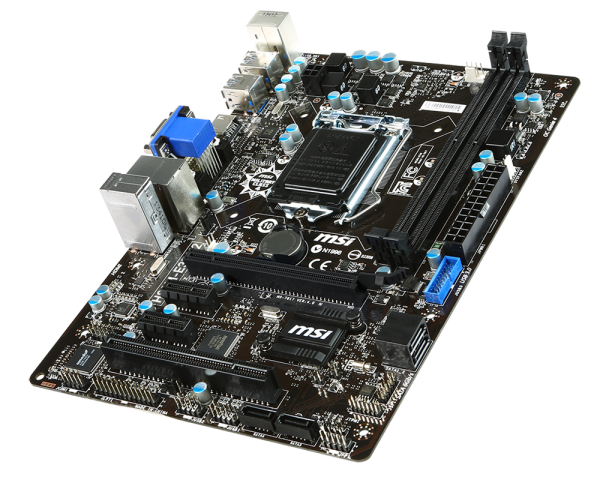MSI H81M-E35 V2 Motherboard Review
Why you can trust Tom's Hardware
In The Box
As is typical for this price range, the H81M-E35 V2 includes minimal accessories. You get the board, a compact manual, a driver CD, an I/O shield and a couple of SATA 6Gb/s cables. As usual, we'll mention that another cable would have been nice, though that's not a significant omission at this price point.
We didn't care much for the manual. It is tiny, measuring a mere 4x6 inches, and you can forget about it staying open to a page. The font looks like eight-point type. Eight languages are covered, including English, French, German, Russian and four other Asian languages, but not Spanish or Dutch. The manual appears to contain a suitable amount of information for a board of this class, but a separate sheet with a much larger image of the front panel (and possibly other) connectors might have been helpful.



The board's layout is logical enough. The only obvious blockage we saw was the first PCIe x1 slot, which would be covered by a dual-slot video card. This is common though, so it's really not an issue. If you need multiple expansion slots, perhaps a full ATX board would be more appropriate for your application. Similarly, a long enthusiast-oriented graphics card (which we don't think would be a natural fit for this low-cost motherboard anyway) might overlap the SATA 6Gb/s ports. They face forward though, so they wouldn't be rendered unusable. If you use cables with clips on them, both clips will face up, so you need to remove the top cable to get to the one below it. Nothing blocks the CR2032 battery, and pin headers are reachable and mostly near edges. The one that isn't, a fan header, would most likely be used with a rear-facing fan, presenting no need to route cables across the board.
There is plenty of room between the RAM slots and the back of a graphics card, allowing the latches to be opened without clearance issues. The CLRCMOS1 header does not include a jumper block. It's on the other side of the chipset rather than being near the battery, but is readily accessible. The four-pin CPU power cable is near the right edge, with nothing between it and the edge that would interfere with cable management. All capacitors are solid, and chokes are a type of ferrite core that MSI calls "Dark Chokes". The front-panel header is in its usual place on the bottom-left, and there is a speaker header there as well so you can hear BIOS error beeps if you plug a speaker in. The audio header is in the back-left, and it isn't right up against anything that would make access difficult. Missing are any LEDs on the board, including +5VSB or diagnostic indicators. Just be extra sure you've switched your PSU off or unplugged it before adding or removing expansion cards.
Get Tom's Hardware's best news and in-depth reviews, straight to your inbox.
-
g-unit1111 I have the H81M-E33 version of this board and after a year of use with a Pentium G-3258 it's still held up surprisingly well. I would definitely recommend these boards in a heart beat.Reply -
Onus I think that's the one that Eric reviewed, and gave it an award. For basic boxes they're an excellent choice; much better than the schlock out there. A mere two SATA ports ought to be a deal-breaker for any rational builder.Reply -
Crashman Reply
No.16445254 said:Will this board support Broadwell CPUs?
http://us.msi.com/support/mb/H81M-E35.html#support-cpu
Unlike DRAM, where similar modules that haven't been tested will probably work, CPUs usually need new firmware specifically written to support them. So you should take MSI's word that it's a no-go. -
f-14 this is a good basic entry level gamer board i have been building with since core 2 duo (G41M-P33 and such) for kids and college students who only want to spend the minimal on a decent gamer. i typically pair this with an Nvidia X60 series graphics card and a 22" monitor and a 460W-500W PSU with a low budget case or lower budget decorative windowed case with the best cfm to noise ratio led fans, usually kingwins.Reply
i try to buy the 4 ram slot versions incase future requirements change and it's cheaper and easier to add in than replace all the ram. -
RedJaron Reply
No, that was the E34. Looks like the main difference between this E35 and my E34 is the one PCI slot at the bottom. And I think your table is off, this looks like a 3+1 VRM. Actual value against the E34 is hard to compare. If you don't need that PCI slot, then why not save $5? However, if you do need it, an extra $5 isn't much.16444324 said:I think that's the one that Eric reviewed, and gave it an award. For basic boxes they're an excellent choice; much better than the schlock out there. A mere two SATA ports ought to be a deal-breaker for any rational builder. -
Onus Modems, cheap wireless adapters, some sound cards, and TV tuners may still use PCI slots. It seems unlikely to me that the average person would have one of those.Reply -
RedJaron Or someone holding on to older, but still perfectly usable tech. If I bought an expensive PCI sound card years ago, I'd likely still use it, particularly if it had DDL. These cheaper boards are exactly the kind that people would get when upgrading older family computers and want to keep things affordable. I think it's very relevant for them to have a few legacy connectors. Older connectors on enthusiast and premium boards are a mystery to me.Reply -
spentshells Nice review, I had an h61 which appears to be pretty much the same board with additional support, it worked great and was extremely stable.Reply